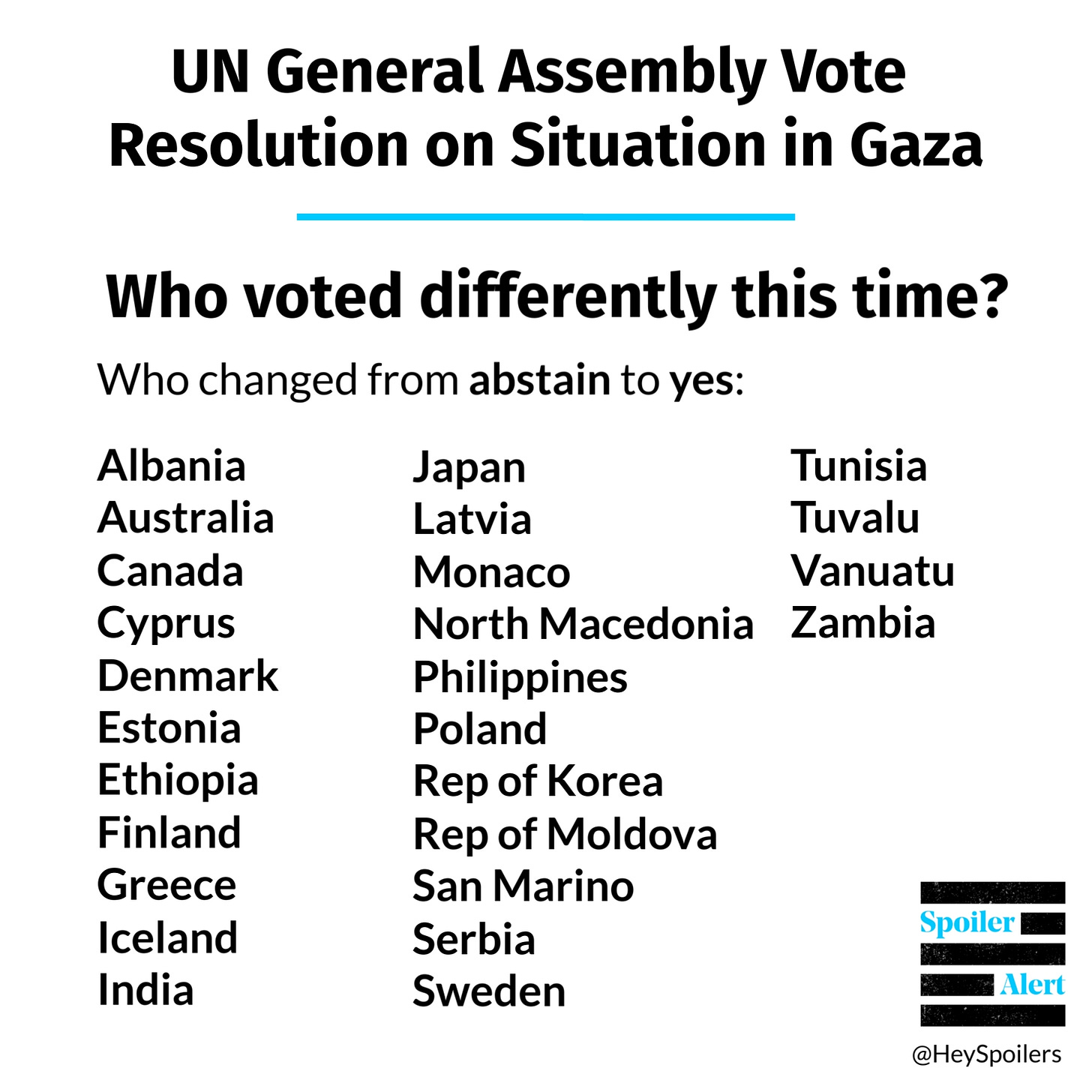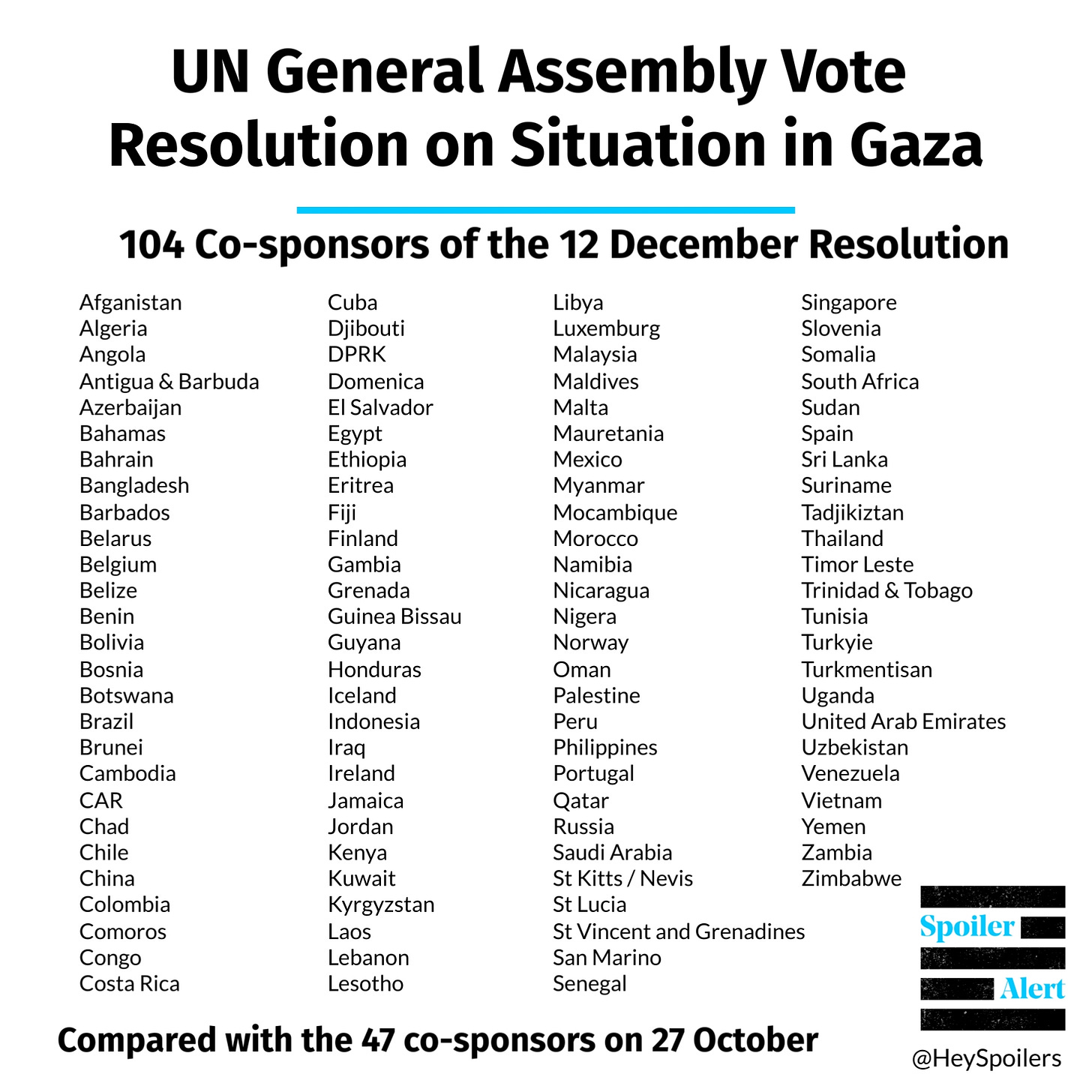DEVELOPING: Here’s the instant breakdown of the UN General Assembly vote on a Gaza ceasefire resolution
35 states switch their votes to support the ceasefire compared to a similar late-October vote
The General Assembly has just voted overwhelmingly for an immediate humanitarian ceasefire in the Gaza Strip with 153 voting in favour, 10 voting against and 23 abstentions.
What was in the resolution?
The text demands “an immediate humanitarian ceasefire” as well as “the immediate and unconditional release of all hostages”. It also makes demands for humanitarian access and compliance with international law. The resolution had 104 Co-sponsors.
The resolution was originally tabled in the Security Council at a historic meeting convened at the request of the Secretary-General on 8 December. After the resolution was scuppered by a US veto, the text was re-introduced as a General Assembly resolution, where all members have a vote and no state has a veto.
How does today’s resolution compare to the 27 October resolution?
Today’s resolution is the second major General Assembly vote calling for an end to hostilities during the current war on Gaza. On 27 October, the General Assembly adopted a similar, but less strongly worded resolution that called for “an immediate, durable and sustained humanitarian truce leading to a cessation of hostilities”. 121 voted in favour, 14 voted against and 44 abstained in the October UN resolution.
Who changed their vote from 27 October?
Of the 44 states that abstained on 27 October, 26 voted in favour of today’s resolution while seven states that previously did not submit a vote also voted in favour today. Croatia and Fiji shifted from voting against the previous resolution to voting in favour of today’s resolution.
Complete breakdown of changes
Below is a full list of those who voted differently on 27 October vs 12 December. The first letter(s) after the country name indicates how they voted on 27 October, the following letter(s) indicates their vote on 12 December.
(A = Abstain; Y = In Favour; N = Against; NV = Did not submit at vote)
Albania: A-Y
Argentina: Y-A
Australia: A-Y
Benin: NV-Y
Burundi: NV-Y
Cambodia: NV-Y
Canada: A-Y
Croatia: N-Y
Cyprus: A-Y
Denmark: A-Y
Equatorial Guinea: Y-A
Estonia: A-Y
Ethiopia: A-Y
Fiji: N-Y
Finland: A-Y
Greece: A-Y
Haiti: A-NV
Hungary: N-A
Iceland: A-Y
India: A-Y
Jamaica: NV-Y
Japan: A-Y
Kiribati: A-NV
Latvia: A-Y
Liberia: NV-N
Malawi: Y-A
Marshall Islands: N-A
Monaco: A-Y
North Macedonia: A-Y
Philippines: A-Y
Poland: A-Y
Republic of Korea: A-Y
Moldova: A-Y
Rwanda: NV-Y
Samoa: NV-Y
San Marino: A-Y
Serbia: A-Y
Seychelles: NV-Y
Sweden: A-Y
Togo: NV-A
Tonga: N-A
Tunisia: A-Y
Vanuatu: A-Y
Zambia: A-Y
Growing support for a ceasefire
The increase in support for today's resolution suggests that the weight of global political opinion is turning even more sharply against Israel’s military assault on Gaza.
Two days after the October vote, Save the Children noted that Israel’s campaign had killed more children in less than a month than were killed in all conflict zones in any single year since 2019. The bombing and ground invasion have resulted in at least 18,000 deaths, 70% of whom are women and children, according to most recent reports from the Ministry of Health in Gaza. The actual figure is expected to be considerably higher given the number of people missing and the huge swathe of the territory which has been reduced to rubble.
(Correction: An earlier version of this article stated 52 states had changed their vote from either No Vote, Abstain, or Against to In Favour. The correct number is 35 states who shifted to In Favour. 26 who previously abstained; 7 who had been a no vote; and 2 who changed from Against to In Favour.)







